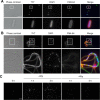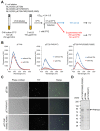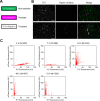Thioflavin T as a fluorescence probe for monitoring RNA metabolism at molecular and cellular levels
- PMID: 25883145
- PMCID: PMC4538803
- DOI: 10.1093/nar/gkv338
Thioflavin T as a fluorescence probe for monitoring RNA metabolism at molecular and cellular levels
Abstract
The intrinsically stochastic dynamics of mRNA metabolism have important consequences on gene regulation and non-genetic cell-to-cell variability; however, no generally applicable methods exist for studying such stochastic processes quantitatively. Here, we describe the use of the amyloid-binding probe Thioflavin T (ThT) for monitoring RNA metabolism in vitro and in vivo. ThT fluoresced strongly in complex with bacterial total RNA than with genomic DNA. ThT bound purine oligoribonucleotides preferentially over pyrimidine oligoribonucleotides and oligodeoxyribonucleotides. This property enabled quantitative real-time monitoring of poly(A) synthesis and phosphorolysis by polyribonucleotide phosphorylase in vitro. Cellular analyses, in combination with genetic approaches and the transcription-inhibitor rifampicin treatment, demonstrated that ThT mainly stained mRNA in actively dividing Escherichia coli cells. ThT also facilitated mRNA metabolism profiling at the single-cell level in diverse bacteria. Furthermore, ThT can also be used to visualise transitions between non-persister and persister cell states, a phenomenon of isogenic subpopulations of antibiotic-sensitive bacteria that acquire tolerance to multiple antibiotics due to stochastically induced dormant states. Collectively, these results suggest that probing mRNA dynamics with ThT is a broadly applicable approach ranging from the molecular level to the single-cell level.
© The Author(s) 2015. Published by Oxford University Press on behalf of Nucleic Acids Research.
Figures






Similar articles
-
Interaction of thioflavin T with amyloid fibrils: fluorescence quantum yield of bound dye.J Phys Chem B. 2012 Mar 1;116(8):2538-44. doi: 10.1021/jp2083055. Epub 2012 Feb 15. J Phys Chem B. 2012. PMID: 22268449
-
Stopped-flow kinetics reveal multiple phases of thioflavin T binding to Alzheimer beta (1-40) amyloid fibrils.Arch Biochem Biophys. 1997 Jun 15;342(2):306-16. doi: 10.1006/abbi.1997.0137. Arch Biochem Biophys. 1997. PMID: 9186492
-
Multiple and cooperative binding of fluorescence light-up probe thioflavin T with human telomere DNA G-quadruplex.Biochemistry. 2013 Aug 20;52(33):5620-8. doi: 10.1021/bi4006072. Epub 2013 Aug 2. Biochemistry. 2013. PMID: 23909872
-
Molecular rotors: what lies behind the high sensitivity of the thioflavin-T fluorescent marker.Acc Chem Res. 2012 Sep 18;45(9):1548-57. doi: 10.1021/ar300053p. Epub 2012 Jun 27. Acc Chem Res. 2012. PMID: 22738376 Review.
-
The Escherichia coli RNA degradosome: structure, function and relationship in other ribonucleolytic multienzyme complexes.Biochem Soc Trans. 2002 Apr;30(2):150-5. Biochem Soc Trans. 2002. PMID: 12035760 Review.
Cited by
-
Thioflavin T indicates mitochondrial membrane potential in mammalian cells.Biophys Rep (N Y). 2023 Oct 31;3(4):100134. doi: 10.1016/j.bpr.2023.100134. eCollection 2023 Dec 13. Biophys Rep (N Y). 2023. PMID: 38026684 Free PMC article.
-
Electrical Capacitance Tomography of Cell Cultures on a CMOS Microelectrode Array.IEEE Trans Biomed Circuits Syst. 2024 Aug;18(4):799-809. doi: 10.1109/TBCAS.2024.3415360. Epub 2024 Aug 21. IEEE Trans Biomed Circuits Syst. 2024. PMID: 38885101 Free PMC article.
-
Real-time monitoring of DNA G-quadruplexes in living cells with a small-molecule fluorescent probe.Nucleic Acids Res. 2018 Sep 6;46(15):7522-7532. doi: 10.1093/nar/gky665. Nucleic Acids Res. 2018. PMID: 30085206 Free PMC article.
-
Nanoscopic Characterisation of Individual Endogenous Protein Aggregates in Human Neuronal Cells.Chembiochem. 2018 Oct 4;19(19):2033-2038. doi: 10.1002/cbic.201800209. Epub 2018 Sep 11. Chembiochem. 2018. PMID: 30051958 Free PMC article.
-
Functional Amyloid and Other Protein Fibers in the Biofilm Matrix.J Mol Biol. 2018 Oct 12;430(20):3642-3656. doi: 10.1016/j.jmb.2018.07.026. Epub 2018 Aug 8. J Mol Biol. 2018. PMID: 30098341 Free PMC article. Review.
References
-
- Elowitz M.B., Levine A.J., Siggia E.D., Swain P.S. Stochastic gene expression in a single cell. Science. 2002;297:1183–1186. - PubMed
-
- Ozbudak E.M., Thattai M., Kurtser I., Grossman A.D., van Oudenaarden A. Regulation of noise in the expression of a single gene. Nat. Genet. 2002;31:69–73. - PubMed
-
- Blake W.J., KAErn M., Cantor C.R., Collins J.J. Noise in eukaryotic gene expression. Nature. 2003;422:633–637. - PubMed
-
- Kussell E., Leibler S. Phenotypic diversity, population growth, and information in fluctuating environments. Science. 2005;309:2075–2078. - PubMed
-
- Süe G.M., Kulkarni R.P., Dworkin J., Garcia-Ojalvo J., Elowitz M.B. Tunability and noise dependence in differentiation dynamics. Science. 2007;315:1716–1719. - PubMed
Publication types
MeSH terms
Substances
LinkOut - more resources
Full Text Sources
Other Literature Sources

